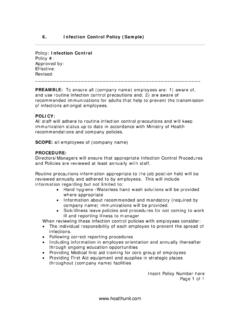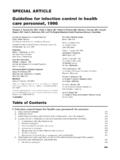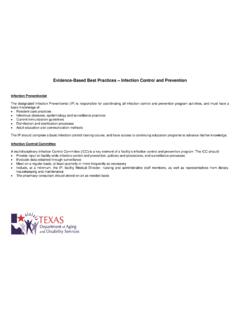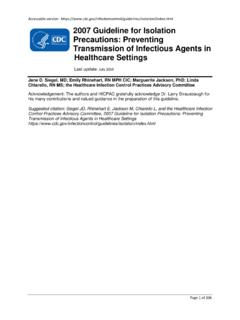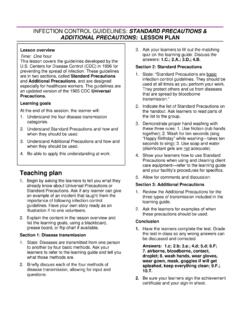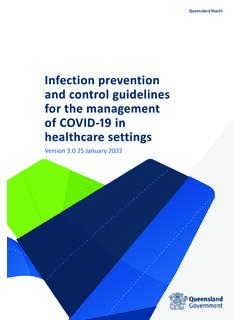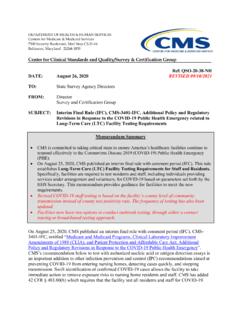Transcription of Universal Precautions/Infection Control Quiz
1 Universal precautions / Infection Control quiz *This quiz is mandatory for all Global Partner (International) Visiting Students INSTRUCTIONS: 1. Please study the educational materials. 2. After reading the materials, take the quiz found on the last page. 3. Print your name clearly at the top. Sign the quiz at the bottom 4. Mail in the quiz only with your application for scoring. Three or more incorrect answers will result in an incomplete application and you will be asked take the quiz again. Unanswered questions are counted as incorrect. Thank you for your cooperation. NORTHWESTERN MEMORIAL HOSPITAL INFECTION Control AND PREVENTION DEPARTMENT 2005 Audience: All staff, including NMH, NMC, contract, temporary and agency personnel and students who have potential to come into contact with blood and/or body fluids Objectives: To identify blood/body fluid exposure risk; To properly and consistently utilize engineering controls and personal protective equipment, policies and procedures to minimize risk of exposure; To understand and comply with reporting procedures and policies in the event of an exposure incident.
2 Training Frequency: Formal training required upon entry into the hospital, annually and whenever there is a change in equipment, procedures or policy. Informal refreshment ongoing Related Policies/ Procedures/Forms: Bloodborne Pathogen Exposure Control Plan Potentially Infectious Medial Waste Management Personal Protective Equipment INF Standard Blood and Body Fluid precautions INF Accidental Exposure to Blood and Body Fluids Infection Control Manual, Section 2 Corporate Health Service Revision: FY 2005 Contact: Infection Control and Prevention 6-2729 Exposure Hotline 6-8282 Safety Management 6-SAFT (7238) INFECTION Control I. Bloodborne Pathogen Standard A. OSHA Standard B. Training C. Standard precautions D. Personal Protective Equipment (PPE) E. Engineering Controls F. Sharps Disposal G. Biohazard Waste Disposal H. Hand Hygiene I.
3 Blood/body fluid Exposure Incidents J. Hepatitis B K. Decontamination and Disinfection L. Further Information II. Tuberculosis (MTB) A. Definition B. Prevention C. Information III. Isolation A. Definition B. Categories of Isolation C. Signage D. Disposal E. Information IV. Respiratory Etiquette Program V. Infection Control Department BLOODBORNE PATHOGEN STANDARD 1. What is the bloodborne pathogen standard? A regulatory document published by the Occupational Safety and Health Administration (OSHA). These regulations require health care facilities to protect its workers through training, availability of protective equipment, creating a safe work environment, and providing a plan for accidental exposure to blood and body fluids. 2. What type of training do I need? Healthcare workers involved in at-risk activities are required to complete bloodborne pathogen training within 10 days of employment, when job activities or responsibilities are changed, and annually.
4 The training includes information about Standard precautions , biohazardous waste handling, the post-exposure policy, and the Hepatitis vaccine. Your manager is responsible for reviewing department specific procedures with you. 3. What are Standard precautions ? Standard precautions is a management program that requires the blood and body fluids of all patients to be treated as potentially infectious with bloodborne pathogens including human immunodeficiency virus (HIV) or hepatitis. 4. What is personal protective equipment and when should I wear it? Personal protective equipment (PPE) is clothing or equipment that protects you from a hazard. What to use depends upon the anticipated exposure. a. Gloves are worn whenever you anticipate contact with blood and/or body fluids. For example, when inserting, removing, or manipulating a venous or arterial line, handling specimens before placed in a specimen bag and when giving an injection.
5 Select the appropriate size glove for your use. b. Gowns are worn when visible contamination of clothing is expected. c. Masks and eye protection or full face shields are worn when splashing or aerosolization of body fluids is anticipated. Depending upon the degree and type of anticipated exposure, protection for the face consists of a surgical mask, goggles or eye glasses with solid side shields, or a protective face shield. Examples for use include suctioning or intubating a patient, inserting or removing venous and arterial lines, phlebotomy procedures and wound irrigation. All PPE must be removed as soon as possible after contamination has occurred. d. Resuscitation devices (CPR pocket masks) must be used during a resuscitation event. These are located in every patient room and in all procedure/treatment areas of the facility. 5.
6 What are engineering controls? Engineering controls are environmental devices that reduce hazards and minimize employee exposure to blood and body fluids. This includes needleless devices, shielded needle devices, plastic capillary tubes, and sharps disposal containers. Proper work practices include no-hands procedures in handling contaminated sharps. 6. How do I appropriately dispose of sharps? Sharps are needles, syringes with and without needles, scalpels, lancets, broken glass - any item that can cause puncture or lacerating injury. ALL sharps are disposed of in hospital approved sharps containers. The inner container is a puncture resistant white plastic box with a white lid. The inner containers are placed in puncture proof, locked, hard plastic enclosures. The outer container must remain locked unless the inner sharps container requires removal and replacement.
7 Sharps containers are removed when they are no more than 3/4 full. Do not dispose of sharps in any other way or in any other container. Never attempt to recap, bend, or break a contaminated sharp. 7. Why are there different waste receptacles garbage cans available? Biohazardous waste, also referred to as medical, regulated, or red bag waste, is defined as any waste item contaminated with blood or body fluids. This waste is segregated at the point of use. All biohazardous waste is placed in a waste can (either labeled as "biohazardous" or red in color) lined with a red bag. General waste, such as food items, flowers, plants, newspapers, and Styrofoam is placed in a waste can lined with a clear garbage bag. Additionally, yellow isolation gowns and gloves without visible contamination should be disposed of in the general waste container.
8 8. When should I use soap and water vs alcohol hand rub for hand hygiene? Adequate hand hygiene is the single most important prevention activity that reduces transmission of infections . Hands must be washed thoroughly with soap and water when visibly soiled and at the beginning of your workday. If hands are not visibly soiled, an alcohol-based hand rub may be used. Hand hygiene is to be performed before and after each patient contact, glove use, food handling and contact with potentially contaminated patient care environments. Soap and water is indicated when caring for patients with known or suspected C. difficile because alcohol does not deactivate spores. Wearing gloves is not a substitute for adequate hand hygiene. 9. Why can t I wear my artificial fingernails at work? Direct patient care givers are prohibited from wearing artificial nails because they harbor bacteria and fungi and have been linked to infections and other untoward events in hospitalized patients.
9 10. What do I do if I am exposed to blood or body fluids? Wash the affected area with soap and water (eye splashes - irrigate with cool water), notify your supervisor, and complete all recommended follow up in Corporate Health Services. During the hours that Corporate Health Service is not open, call the exposure hot line pager at 5-7804. 10. Why is eating and drinking prohibited in patient care areas including nursing stations? Eating and drinking in patient care areas is not safe due to potential contamination of food and beverages. The Occupational Health and Safety Administration (OSHA) and the Illinois Department of Public Health (IDPH) require that hospitals provide clean areas away from patient care areas where we may eat and drink (conference/report rooms, cafeterias and dining rooms). 11. What is Hepatitis B and how do I protect myself?
10 Hepatitis B is a bloodborne virus with an unpredictable course of illness/symptoms. Healthcare workers are 20 times more likely than the general public to contract Hepatitis B through occupational exposure. Transmission can occur from needlesticks, through sexual contact, and from any surface contaminated with infected blood. The virus is not spread through casual contact. In addition to following Standard precautions , there is a Hepatitis B vaccine available for the healthcare worker who has exposure to blood and body fluids. The vaccine is a series of 3 shots given over a 6 month period of time and is offered through Health Services. 12. What about decontamination and disinfection of work surfaces? When a work surface becomes contaminated with blood, body fluid, and/or tissue, decontamination and disinfection procedures must be followed.




